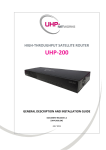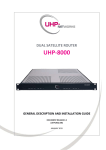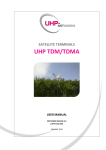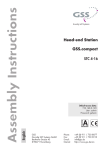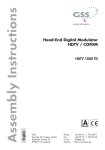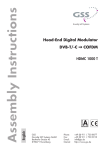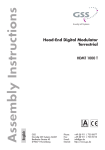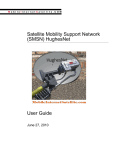Download General Description and Installation Guide
Transcript
OUTDOOR SATELLITE ROUTER UHP-1200 GENERAL DESCRIPTION AND INSTALLATION GUIDE DOCUMENT RELEASE 3.2 [UHP.OR32.EN] AUGUST 2015 UHP-1200 OUTDOOR SATELLITE ROUTER GENERAL DESCRIPTION AND INSTALLATION GUIDE, v3.2 CONTENT Acronyms and Abbreviations ..........................................................................................................4 Introduction .....................................................................................................................................6 Required level of qualification ..................................................................................................................6 Document version and applicability..........................................................................................................6 Copyright ...................................................................................................................................................6 1. General description ..............................................................................................................7 1.1 System overview .......................................................................................................................7 1.2 Measurement equipment, tools and accessories ....................................................................7 1.3 Labeling and sealing..................................................................................................................7 1.4 Packaging and content..............................................................................................................8 1.5 Description and principles of operation ...................................................................................8 1.5.1 1.5.2 1.5.3 1.5.4 1.5.5 2. Overview ...................................................................................................................................8 Power connector (DC IN) ..........................................................................................................9 LAN interface connector ...........................................................................................................9 IF Rx input .................................................................................................................................9 IF Tx Modulator output.............................................................................................................9 Operations ..........................................................................................................................10 2.1 Operational limits ...................................................................................................................10 2.2 Preparation for use .................................................................................................................10 2.2.1 2.2.2 2.2.3 2.2.4 2.2.5 2.2.6 2.2.7 3. Unpacking ...............................................................................................................................10 Installation ..............................................................................................................................10 Connecting to external devices ..............................................................................................10 Powering on ............................................................................................................................11 Local access to router via HTTP interface ...............................................................................11 Remote Telnet access .............................................................................................................11 Command Interface ................................................................................................................11 Operations ..........................................................................................................................12 3.1 Software updates....................................................................................................................12 3.2 Powering off ...........................................................................................................................12 3.3 Safety instructions for operations ..........................................................................................12 4. Troubleshooting .................................................................................................................13 5. STORAGE, TRANSPORTATION AND DISPOSAL ....................................................................15 © UHP Networks Inc. 2015 2 www.uhp.net UHP-1200 OUTDOOR SATELLITE ROUTER GENERAL DESCRIPTION AND INSTALLATION GUIDE, v3.2 FIGURES Figure 1 Structure of UHP Manuals...............................................................................................................6 Figure 2 UHP-1200 Outdoor Satellite Router ................................................................................................7 Figure 3 Labeling of UHP-1200 satellite router .............................................................................................8 Figure 4 UHP-1200 Architecture ...................................................................................................................8 Figure 5 UHP-1200 series modem – rear view ..............................................................................................9 TABLES Table 1 Operational limits ...........................................................................................................................10 Table 2 Pinout of 8P8C LAN interface (RJ45) ..............................................................................................10 Table 3 Troubleshooting guide....................................................................................................................13 © UHP Networks Inc. 2015 3 www.uhp.net UHP-1200 OUTDOOR SATELLITE ROUTER GENERAL DESCRIPTION AND INSTALLATION GUIDE, v3.2 ACRONYMS AND ABBREVIATIONS 16APSK 32APSK 8PSK AGC BCH BUC C/N CRTP DAMA DSCP DVB Eb/No EIRP ETSI FEC Frame Hard priority HTTP HUB Hubless HW ICMP IESS IFL IGMP Inroute IP LDPC LNB Local oscillator Long frames Master MCPC Mesh MF-TDMA MODCOD NMS Node Station ODU Outroute QPSK RF level RSV 16 Amplitude and Phase-shift keying or Asymmetric Phase-shift keying, (APSK), is a digital modulation scheme that conveys data by changing, or modulating, both the amplitude and the phase of a reference signal (the carrier wave). 32 Amplitude and Phase-shift keying or Asymmetric Phase-shift keying, (APSK), is a digital modulation scheme that conveys data by changing, or modulating, both the amplitude and the phase of a reference signal (the carrier wave). Phase-shift keying (PSK) is a digital modulation scheme that conveys data by changing, or modulating, the phase of a reference signal (the carrier wave). Automatic Gain Control BCH code is a multilevel cyclic variable-length digital error-correcting code used for correcting multiple random error patterns. BCH codes may also be used with multilevel phase-shift keying whenever the number of levels is a prime number or a power of a prime number. Block Up-Converter (BUC) is used in the transmission (uplink) of satellite signals. It converts a band (or "block") of frequencies from a lower frequency to a higher frequency. Carrier-to-noise ratio, often written as CNR or C/N, is the signal-to-noise ratio (SNR) of a modulated signal. Compressing IP/UDP/RTP Headers for Low-Speed Serial Links Demand Assigned Multiple Access. Channel establishment on demand. Differentiated Services Code Point (DSCP) is a 6-bit field in the header of IP packets for packet classification purposes. DSCP replaces the outdated IP precedence, a 3-bit field in the Type of Service byte of the IP header originally used to classify and prioritize types of traffic Digital Video Broadcasting (DVB) is a suite of internationally accepted open standards for digital television. Eb/N0 (the energy per bit to noise power spectral density ratio) is an important parameter in digital communication or data transmission. It is a normalized signal-to-noise ratio (SNR) measure, also known as the "SNR per bit". It is especially useful when comparing the bit error rate (BER) performance of different digital modulation schemes without taking bandwidth into account. Effective Isotropically Radiated Power The European Telecommunications Standards Institute (ETSI) is an independent, non-profit, standardization organization in the telecommunications industry (equipment makers and network operators) in Europe, with worldwide projection. In telecommunication and information theory, forward error correction (FEC) is a system of error control for data transmission, whereby the sender adds redundant data to its messages, also known as an error-correction code. TDMA service packet describing which station should transmit in which time slot . Generated ~10 times per second. Method of transmission queues handling when packets from lower priority queue are not transmitted until all packets from higher priority queue are transmitted. Hypertext Transfer Protocol (HTTP) is an application-level protocol for distributed, collaborative, hypermedia information systems. Central Station of satellite network that is managing all the terminals and resources Special mode of operation when all stations are transmitting to one TDMA carrier and all receiving this carrier. Hardware The Internet Control Message Protocol (ICMP) is used by networked devices to send error messages—indicating, for instance, that a requested service is not available or that a host or router could not be reached. Intelsat Earth Station Standards Connection from the indoor equipment (modem/router) to the outdoor equipment at the antenna normally involves two inter-facility (IFL) cables. The Internet Group Management Protocol (IGMP) is a communications protocol used by hosts and adjacent routers on IP networks to establish multicast group memberships. Channel from stations to hub. IP is the usual abbreviation for Internet Protocol. Low-density parity-check (LDPC) code is a linear error correcting code, a method of transmitting a message over a noisy transmission channel, and is constructed using a sparse bipartite graph. Low-noise block converter is the receiving converter installed at satellite antenna. Oscillator built into RF block converter ( BUC or LNB ). Value of LO is usually written on block enclosure or in datasheet. DVB-S2 frames 64800 bits long (including FEC). Require slightly lower C/N than short frames. Main station of Hubless network. Master allocates bandwidth and performs stations acquisition. Multiple channels per carrier. All TDM carriers generated by UHP can be treated as MCPC. Even if they are called SCPC. Capability of station allowing to receive other stations via TDMA link. TDMA working on several RF channels simultaneously. All MF channels work as one aggregate TDMA channel. Modulation and coding mode. Network Management System Terminal of satellite network which is able to receive information directly from other network terminals Out-Door Unit Forward TDM channel (MCPC) from HUB to stations. Phase-shift keying (PSK) is a digital modulation scheme that conveys data by changing, or modulating, the phase of a reference signal (the carrier wave). Absolute RF level of entire signal (carrier + adjacent carriers) expressed in dBm. Reed–Solomon error correction is an error-correcting code that works by oversampling a polynomial constructed from the data. © UHP Networks Inc. 2015 4 www.uhp.net UHP-1200 OUTDOOR SATELLITE ROUTER GENERAL DESCRIPTION AND INSTALLATION GUIDE, v3.2 SCPC Short frames SNMP SNTP SNR SR Star SW TDM TDMA Telnet Terminal TFTP Timestamp Time-slot UDP USB VLAN VoIP VSAT WFQ X-modem Single Channel Per Carrier DVB-S2 frames 16200 bits long (including FEC). Advisable to use at lower symbol rates. Produce less delay than Long frames. Simple Network Management Protocol Simple Network Time Protocol (SNTP) is a protocol and software implementation for synchronizing the clocks of computer systems over packet-switched, variable-latency data networks. Signal-to-noise ratio is an electrical engineering measurement defined as the ratio of a signal power to the noise power corrupting the signal. Symbol Rate Type of network with one central station (hub) and several peripheral stations. Software Time Division Multiplexing Time Division Multiple Access Telecommunication Network (Telnet) is a network protocol used on the Internet or local area networks to provide a bidirectional interactive communications facility. Typically, telnet provides access to a command-line interface on a remote host via a virtual terminal connection. Earth Stations (usually VSAT) operated under management of network HUB Trivial File Transfer Protocol (TFTP) is a file transfer protocol, with the functionality of a very basic form of File Transfer Protocol (FTP). Time format used by UHP. Plus sign at the beginning (+HH:MM:SS or +NN d HH:MM:SS)denotes relative time from some event or UHP start-up. If UHP has time synchronized to hub or SNTP absolute time can be displayed. Time zone affects absolute time. Time interval for station transmission. The User Datagram Protocol (UDP) is the set of network protocols used for the Internet. With UDP, computer applications can send messages, in this case referred to as datagram, to other hosts on an Internet Protocol (IP) network without requiring prior communications to set up special transmission channels or data paths. USB (Universal Serial Bus) is a specification to establish communication between devices and a host controller (usually personal computers). A virtual LAN, commonly known as a VLAN, is a group of hosts with a common set of requirements that communicate as if they were attached to the same broadcast domain, regardless of their physical location. Voice over Internet Protocol (VoIP) is a general term for a family of transmission technologies for delivery of voice communications over IP networks such as the Internet or other packet-switched networks. Very Small Aperture Terminal – satellite earth station with small-size antenna Weighted fair queuing. Method of proportional division of bandwidth between transmission queues. Simple file-transfer protocol © UHP Networks Inc. 2015 5 www.uhp.net UHP-1200 OUTDOOR SATELLITE ROUTER GENERAL DESCRIPTION AND INSTALLATION GUIDE, v3.2 INTRODUCTION This document presents a general description of the UHP-1200 series satellite routers and is intended for familiarization with the system capabilities and specifications. This manual is applicable to all the key modes of the router operations. Required level of qualification This manual is intended for engineering personnel operating VSAT networks. Such specialists should have adequate educational credentials in the field of electronics and sufficient experience and skills in data networks administration and satellite systems. Document version and applicability UHP VSAT platform is based on the universal satellite router UHP, which is available in different fully-compatible hardware modifications. UHP satellite router is a basic element of any network architecture and can be used in any combinations and at any hierarchy level. Router functional capabilities and its operating modes are determined by the installed software and its configuration. This manual is applicable to all UHP-1200 series outdoor satellite routers (previously known also as UHP-1000-OD) with software release 3.2 or higher. When ordering this document, please specify its ID: [UHP.OR32.EN]. System Level (Network engineering guide) Network Engineering SCPC Modem Service Level (User manual) TDM/TDMA Terminal Hubless TDMA Station UHP-8000 UHP-IFS Hardware Level (Installation guide and specifications) UHP-1200 UHP-200 NMS Figure 1 Structure of UHP Manuals Copyright The content of this document is the intellectual property of UHP Networks Inc. (referred to below as UHP Networks). Copying or quoting this description as a whole or of any part of it without a written permission from UHP Networks is prohibited. © UHP Networks Inc. 2015 6 www.uhp.net UHP-1200 OUTDOOR SATELLITE ROUTER GENERAL DESCRIPTION AND INSTALLATION GUIDE, v3.2 1. 1.1 GENERAL DESCRIPTION System overview UHP satellite routers are essentially a universal solution for geographically distributed VSAT-class satellite communication networks. UHP routers can be used to organize simple point-to-point channels, “star”- and “mesh”-topology networks with several hierarchy levels and bandwidth-on-demand capabilities. UHP VSAT platform is based on many innovation technologies. It was developed using long-term experience in satellite service provisioning. Nowadays electronics achievements made it possible to make VSAT platform compact and assure its efficiency and reach functionality. Weatherproof UHP-1200 satellite router can be installed outdoors, for example, directly on the antenna. IP67 design ensures reliable operation over a wide temperature range. Figure 2 UHP-1200 Outdoor Satellite Router Technical characteristics are given in the appropriate product specification sheets. 1.2 Measurement equipment, tools and accessories The router can be accessed via LAN. Standard computer (notebook) is required to configure and monitor status of UHP-1200 satellite router. The computer must be equipped with a LAN interface, and also have the following software installed: 1.3 Internet browser (WEB browser) Telnet Client (optional) The Terminal (e.g.: Hyperterminal, included in the OS Windows) (optional) Labeling and sealing The product is marked with the unique Serial Number, as well as Part Number on the bottom of the router case. The warranty seals are located on the bottom of the product, at the junction of the two parts of the case. Product warranty will automatically void if such labels have been removed, modified or damaged. © UHP Networks Inc. 2015 7 www.uhp.net UHP-1200 OUTDOOR SATELLITE ROUTER GENERAL DESCRIPTION AND INSTALLATION GUIDE, v3.2 Figure 3 Labeling of UHP-1200 satellite router 1.4 Packaging and content Standard UHP-1200 package includes: 1. Satellite router UHP-1200; 2. Installation kit. It is recommended to keep original packaging throughout the entire lifetime. Conservation, storage and transportation of the terminal must be in original packaging. 1.5 Description and principles of operation UHP-1200 UHP-1100 Router board TDMA Rx MCPC Rx IF Splitter LAN Tx DC IN LAN DC IN IF Rx IF Tx Figure 4 UHP-1200 Architecture 1.5.1 Overview UHP-1200 Satellite router has a weatherproof, sealed housing and without any serviceable parts inside. External devices should be connected through connectors on the bottom interface of the device. The LAN port is used both for connection to the user’s network and for configuration and control of the router. © UHP Networks Inc. 2015 8 www.uhp.net UHP-1200 OUTDOOR SATELLITE ROUTER GENERAL DESCRIPTION AND INSTALLATION GUIDE, v3.2 Figure 5 UHP-1200 series modem – rear view 1.5.2 Power connector (DC IN) UHP-1200 router is powered with 24 VDC. AC/DC Power supply adaptor is not supplied. The router can be powered from different DC power sources (batteries, DC-DC converter). The router can provide power to RF hardware within the current according to the specifications of the router. 1.5.3 LAN interface connector LAN connector is purposed for connecting to Ethernet switch using a straight cable. Bit rate 10 or 100 and duplex mode are software selectable. 1.5.4 IF Rx input This interface is intended to connect the router to the LNB. The received signal via the built-in splitter (see Figure 4) is fed to a DVB and TDMA demodulators of the router. The input, on the router side, can be fed with 18 VDC power supply. Whether power source in on or off, the input can withstand external voltage up to 50 VDC (power supply circuit is provided with a diode). Power supply circuit is protected with a thermal fuse operating in case of short circuiting. After short circuiting is removed it may be required to disconnect load from Rx inputs for several seconds so as to allow the fuse to return to its initial state. Cable length and cable quality (losses level) can affect the quality and possibility of receiving signals. THE TOTAL CURRENT CONSUMED BY EXTERNAL EQUIPMENT THROUGH BOTH RX INPUTS SHOULD NOT BE IN EXCESS OF 750 MA. NORMALLY, CURRENT CONSUMPTION BY DRO LNB - 150 MА, PLL LNB - 500 MА. 1.5.5 IF Tx Modulator output IF TX OUTPUT CAN FEATURE 24 VDC WITH A HIGH SHORT-CIRCUIT CURRENT. SHORT CIRCUITING CAN CAUSE SPARKLE SPREAD AND BURNS. THIS VOLTAGE CAN DAMAGE MEASUREMENT EQUIPMENT IF IT IS NOT PROTECTED AT ITS INPUTS. SUPPLYING EXTERNAL VOLTAGE TO THIS CONNECTOR IS OBJECTIONABLE AND SUPPLYING MORE THAN 24 V IS PROHIBITED. UHP-1200 modulator is compatible with most satellite transmitters/converters (BUC). Modulator is connected directly to the IF Tx connector. The router provides 24 VDC power supply to the BUC and 10 MHz reference signal. UHP-1200 is not provided with a separate protection on the transmitter power supply circuitry. Use is made of current protection for the power supply adapter. In case of a short circuit the router is de-energized and then gets restarted. If power supply is switched on in the configuration, restarts continue at 5 seconds interval until short circuiting is removed. ANY OPERATIONS WITH IF TX CABLE SHOULD BE PERFORMED WITH 24 V SUPPLY VOLTAGE TURNED OFF. OTHERWISE, SELF-INDUCTION ACROSS A LONG CABLE CAN DAMAGE THE TRANSMITTER AND/OR THE ROUTER. © UHP Networks Inc. 2015 9 www.uhp.net UHP-1200 OUTDOOR SATELLITE ROUTER GENERAL DESCRIPTION AND INSTALLATION GUIDE, v3.2 2. 2.1 OPERATIONS Operational limits Table 1 Operational limits Limits # Parameter 1 2 3 4 5 6 7 8 Router DC Input voltage Output current at Tx Out interface Input voltage on the Tx Out interface Output current at Rх SCPC or RX TDMA Input voltage on other interfaces Operational temperature Relative humidity (@ 250С) Atmospheric pressure (mm Hg) Mechanical impacts (acceleration with an amplitude not exceeding 1,25 mm): - in a range 0,5 – 15 Hz: - in a range 15-40 Hz: - in a range 40-300 Hz: 9 2.2 2.2.1 Minimum 23 VDC 0С 0% 720 Maximum 25 VDC 2A 24 V 0,75 А 18 V +40 0C 90% 770 2,45 m/s 5,88 m/s 14,7 m/s Preparation for use Unpacking Before opening the packaging please check a safety of transport container. If there is any visible damage of packaging you should keep it as long as the delivered equipment will be properly tested. 2.2.2 Installation UHP-1200 Router is designed for installation on any flat, stable surface or on an antenna mount with the included universal installation kit. The router should be installed in a place protected from direct sunlight. Table 2 Pinout of 8P8C LAN interface (RJ45) Пин 1. 2. 3. 4. 5. 6. 7. 8. Назначение Rx + Rx Tx+ DC + DC + Tx DC DC - 2.2.3 Connecting to external devices All wire connections must be performed before powering up the router. Cable connectors should be screwed to the router without use of any mechanical instruments. Please, avoid excessive force when connecting IF cables. WARNING! DO NOT CONNECT OR DISCONNECT ANY CONNECTING CABLES TO THE ROUTER WITH THE POWER ON. THIS CAN LEAD TO A FAILURE OF THE ROUTER AND CONNECTED DEVICES. © UHP Networks Inc. 2015 10 www.uhp.net UHP-1200 OUTDOOR SATELLITE ROUTER GENERAL DESCRIPTION AND INSTALLATION GUIDE, v3.2 2.2.4 Powering on In a few seconds after powering the router it is ready for use. The actual status of the router can be checked using its web interface (via LAN). With factory setting the router is configured as TDM/TDMA terminal. The router requires change of mode of operation (if necessary) and/or configuration of respective network parameters before login into satellite networks. The easiest way to configure the router is using its HTTP access via its LAN port. The router can be reset by short (2-3 sec.) power interruption. 2.2.5 Local access to router via HTTP interface HTTP (web) interface allows configuration key parameters and monitoring its actual status of the router. Local Web page of the router can be accessed from any Internet browser. By default, UHP-1200 router is configured with IP-address 192.168.222.222 with mask 255.255.255.248 (/29). Respectively, the computer should be configured with an address, e.g. 192.168.222.217 with the same mask. In case the satellite routers have been preconfigured at the factory on customer’s request such routers may have different default IP address. In such case the respective IP addresses will be listed in the passport of the router. If it’s impossible connecting the router with any of specified addressed please reset the router to factory settings. 2.2.6 Remote Telnet access Remote access to the configuration can be performed using Telnet protocol. The connection can be provided to any of IP addresses that are set on the router. UHP-1200 supports simultaneously only one Telnet session. In order the hang session does not block access to the device forever in case on non-activity (pressing ENTER key), the router auto-terminates the session after a certain time of inactivity. The time can be set in the configuration, and by default it is 10 minutes. 2.2.7 Command Interface Please refer to the Command Interface manual applicable for the respective version of SW and activated mode of operation of the UHP router. The Command Interface manuals are available for download and online use on the website: http://www.uhp.net. © UHP Networks Inc. 2015 11 www.uhp.net UHP-1200 OUTDOOR SATELLITE ROUTER GENERAL DESCRIPTION AND INSTALLATION GUIDE, v3.2 3. OPERATIONS UHP Routers belong to the class of unattended equipment and during its operation does not require any special staff exploitation. When operated as SCPC station or TDM/TDMA terminal the satellite router does not require any changes of settings or it is configured remotely from the Hub. The tasks of operational staff are limited to the following: 3.1 Monitoring of climatic environment of operation, ensuring the absence of dust, preventing the ingress of moisture on the surface of the device. Should provide unrestricted air access to router for cooling. Cables connected to the device must not suffer any significant impact on the connections of the router. All connectors must be properly attached and secured. Software updates One of the key advantages of UHP satellite routers is the ability to extend the functionality by updating the software. Software updates also include fixes for known bugs and improving the algorithms of the system. 3.2 Powering off The router can be powered off by disconnecting its DC cord from the power supply. 3.3 Safety instructions for operations Connect and disconnect any cables only when router is powers off; The router must have a reliable grounding; Do not try to repair the router and not use it for other purposes; There no serviceable components inside, opening a housing is not permitted; Servicing by qualified personnel only. © UHP Networks Inc. 2015 12 www.uhp.net UHP-1200 OUTDOOR SATELLITE ROUTER GENERAL DESCRIPTION AND INSTALLATION GUIDE, v3.2 4. TROUBLESHOOTING Table 3 Troubleshooting guide Symptoms Router doesn’t work Router restarts every 3-5 seconds. No reception from the satellite (indicator LOCK is off, single flashes of ERROR indicator) Possible reasons Actions DC power beyond the limits of allowed values Power cord is broken Check DC power voltage Short-circuit in transmit cable Disconnect and check Tx cable Software failure Reset software to factory defaults Incorrect configuration Check Rx frequency and symbol rate. IF cable failure Check Rx cable and make sure that its connectors are properly connected to the LNB and the router. LNB is not powered Check if LNB power is switched on Disconnect Rx IF cable from LNB and make sure that 12-18 VDC is available on the connector. Check Rx level in the statistic of the demodulator. No carrier on the satellite or its level is insufficient. Verify availability of the carrier and its level with spectrum analyzer. Contact Hub administrator and investigate if the carrier is properly transmitting and local weather conditions not attenuate the signal. Measure carrier signal to noise level with a spectrum analyzer. Verify if antenna is properly pointed to the satellite and there no obstacles in the direction to the satellite. Check the integrity of the film of antenna’s feed horn and absence of moisture in it. Replace LNB to the spare one The quality of reception may temporary decrease during intensive rainfall, for, thunderstorm cloudiness. Check if there is no snow or ice on the antenna surface and on the feed horn. Check C/N in demodulator’s statistics. Verify if antenna is properly pointed to the satellite and there no obstacles in the direction to the satellite. Check the integrity of the film of antenna’s feed horn and absence of moisture in it. Check Eb/No in demodulator’s statistics. Contact Hub administrator and investigate if the carrier is properly transmitting and local weather conditions not attenuate the signal Check Tx frequency and symbol rate of the modulator. Make sure that transmission is enabled Low Rx carrier level High rate of errors of Rx path LNB failure Bad weather conditions Low signal to noise level Low Rx carrier level Interferences Station is not transmitting © UHP Networks Inc. 2015 Wrong network setting 13 Check the power cable and output voltage. Replace a cable. www.uhp.net UHP-1200 OUTDOOR SATELLITE ROUTER GENERAL DESCRIPTION AND INSTALLATION GUIDE, v3.2 Symptoms Station is not transmitting Possible reasons Actions Transmission of the terminal is not allowed by Hub (only for TDM/TDMA terminal) IF Tx cable failure BUC is not powered Other symptoms BUC failure Other reasons Contact Hub administrator Check Tx cable and make sure that its connectors are properly connected to the BUC and the router. Check if BUC power is switched on Disconnect Tx IF cable from BUC and make sure that 24 VDC is available on the connector. Replace the BUC on the spare one Contact your dealer or service center In many cases, reinstalling system software allows to restore a satellite router functionality, which may need reset to the factory default configuration. If the recovery of software cannot be implemented successfully, or if this operation does not eliminate the defect, it is necessary to illuminate the faulty device and replace it by new device. © UHP Networks Inc. 2015 14 www.uhp.net UHP-1200 OUTDOOR SATELLITE ROUTER GENERAL DESCRIPTION AND INSTALLATION GUIDE, v3.2 5. STORAGE, TRANSPORTATION AND DISPOSAL Storage and transportation of satellite routers must be performed in original packaging. Equipment can be stored and transported in pallet with height not more than 10 devices. Storage and transportation should comply with the following conditions: - limiting low temperature of storage (minus 40 ± 2) ° C; - limiting high temperature of storage (50 ± 2) ° C. - atmospheric pressure 720 ÷ 770 mm. Hg. Utilization of satellite routers must be in accordance with the rules for disposal of industrial or consumer electronics in accordance with applicable law. © UHP Networks Inc. 2015 15 www.uhp.net















